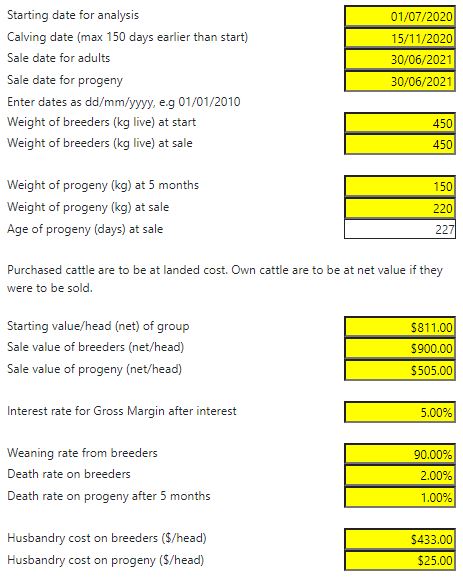Example two: Assessing a drought feeding option
Copy the example scenario (Cowtrade drought feeding cows and calves) from the examples list and open the scenario, this will illustrate how the program may be used in the following example.
Note: The yellow cells are for inputs and can be adjusted, while the rest are calculated outputs.
The Cowtrade program allows for the input of Standard weight of one Adult Equivalent and Extra Adult Equivalents for cow weaning a calf, the default values being 455kg and 0.35 respectively, see figure 1. One Adult Equivalent is a non-lactating animal of average 455kg liveweight carried for a year. It is generally unnecessary to change these values unless the user is using a different Adult Equivalent convention for comparing grazing pressure and they wish to tailor it to their requirements. If the analysis period is less than the duration of pregnancy plus five months, a proportional value for the adult equivalent rating of the calf is calculated.
Example two describes how to use this program when a grazier is faced with the difficult decision of whether to hold or sell breeders going into a drought.
Some key assumptions must be made in order to do this:
- What is the breeder unit worth (net of selling expenses) now? This could be a cow and calf unit that will need to be fed for a considerable periodif it is retained in the herd until weaning time.
- What will the breeder unit be worth at the end of the period? This could be at the expected time of the drought breaking (end of the feeding period) or the weaner being sold off the mother or the time that the cow and calf unit will be replaced.
- How much will it cost to retain the breeder unit over this period?
Scenario: The grazier is running out of feed for a group of PTIC cows and can either sell them now (01/07/2017) for $800 per head net or hold them and feed them. If they are sold, the decision would be to replace the breeder units with cow and calf units in about June the following year. The calves are likely to be close to weaning age at this time. The expected landed replacement cost is $1228 ($810 +$418).
The steps below take the user through the data entry for this scenario displayed in Figure 2.
- Begin by entering the Start date for the analysis (01/07/2017), Expected calving date, expected future Sale date for adults, Sale date for progeny, Weight of breeders at start and sale, Weight of progeny at 5 months and sale. Sale can be either a normal sale, or a transfer at valuation of weaner or breeder back into the herd. These dates and weights are used mainly to calculate adult equivalents.
- When entering the Starting value/head of group for a destocking analysis assessing breeders already in the herd, the net value that would be achieved if that animal were to be sold should be used, there are calculators in the Cowtrade program which will help the user calculate these values, they are located below the scenario summaries in the web page.
- Sale values may be entered as per head net values, or may be calculated from weights, price per kilogram and selling and transport costs using the calculators at the bottom of the web page. Explanation and examples for the use of the calculators can be found in the Cowtrade calculators page.
- Enter the Interest rate for Gross Margin after interest, this should be viewed as the opportunity cost, especially if using business funds rather than borrowed funds.
- Enter the appropriate Weaning rate from breeders and Death rate on stock classes.
- Enter expected Husbandry cost for the stock classes based on the duration of the analysis.

